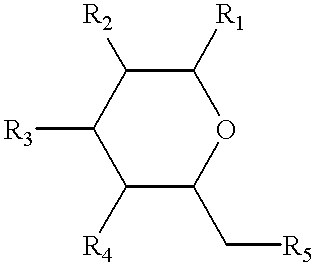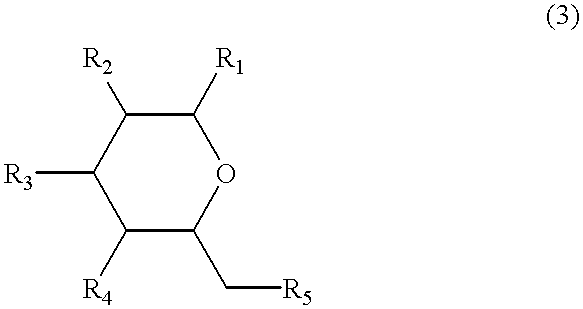Non-peptide peptidomimetics
a peptide and non-peptide technology, applied in the field of non-peptide peptidomimetics, can solve the problems of limited therapeutic applications involving peptides, lack of bioavailability of peptides as potential therapeutic agents via oral administration, and generally very short biological half-lives, so as to improve the activity of analogs and improve the duration of action and activity.
- Summary
- Abstract
- Description
- Claims
- Application Information
AI Technical Summary
Benefits of technology
Problems solved by technology
Method used
Image
Examples
example 2
Preparation of Analog Having Structure (7), 2-(1-Phenylsulfonyl-indol-3yl)ethyl-6-O-(5-acetamidopentyl)-2,3,4-tri-O-benzyl-.beta.-D-glucopyranoside
To a solution of 5-amino pentanol (0.75 g, 7.27 mmol) in methanol (15 ml, 0.5 M) at 0.degree. C. was added triethylamine (1.62 ml, 1.6 equiv, 11.6 mmol) followed by acetic anhydride (0.891 ml, 1.3 equiv, 9.45 mmol). The reaction mixture was warmed to room temperature and stirred overnight. TLC (8% CH.sub.3 OH / CH.sub.2 Cl.sub.2) stained with ninhydrin revealed starting material. Triethylamine (1.6 ml, 1.6 equiv, 11.6 mmol) was added to room temperature followed by acetic anhydride (0.9 ml, 1.3 equiv, 9.45 mmol) and the reaction mixture was stirred an additional night. Concentration and flash chromatography (silica, 7% CH.sub.3 OH / EtOAc) afforded N--CH.sub.3 CO-5-amino-pentanol (1 g, 100%).
Sodium hydride (0.108 g, 60% suspension in oil, 0.307 mmol, 2.2 equiv. compared to N--CH.sub.3 CO-5-amino-pentanol) was quickly weigh into a flame dried ...
example 3
Preparation of Analog Having Structure (2), 2-(1H-indol-3-yl)ethyl-6-O-(5-aminopentyl)-2,4-di-O-deoxy-.beta.-D-glucopyranoside
A. Methyl 2-O-benzoyl-4,6-O-isopropylidene-.alpha.-D-glucopyranoside
To a stirred solution of methyl 2-4,6-O-isopropylidene-.alpha.-D-glucopyranoside (28.8 g, 123 mmol) in 410 mL of dichloromethane at 0.degree. C. was added triethylamine (25.7 mL, 185 mmol) followed by benzoic anhydride (30.73 g, 135 mmol). The solution was warmed to room temperature and stirred for 24 hours. The solvent was removed under reduced pressure and the residue was extracted with ethyl acetate (500 mL) and washed with H.sub.2 O (1.times.200 mL), a saturated salt solution (1.times.200 mL), and dried over magnesium sulfate. Concentration and flash chromatography (silica, 25% ethyl acetate in petroleum ether) provided the target compound (33.4 g, 80%) as a white form.
B. Methyl 2-O-benzoyl-3-O-(methylthio)thiocarbonyl-4,6-O-isopropylidene-.alpha.-D glucopyranoside
To a stirred solution of...
example 4
Preparation of Analog Having Structure (13), Methyl 2,3,4-tri-O-benzyl-6-O-(N-trifluoroacetyl-5-aminopentyl)-.beta.-D-glucopyranoside
A. Methyl 6-O-tert-butyldiphenylsilyl-.beta.-D-glucopyranoside
To a stirred solution of methyl .beta.-D-glucopyranoside (5 g, 25.7 mmol) in 51 mL of dry DMF was added at room temperature imidazole (5.46 g, 80.2 mmol) followed by tert-butyldiphenyl-silyl chloride (11.3 mL, 43.4 mmol). The solution was heated to 50.degree. C. for 24 hours and the DMF was removed under reduced pressure. The reaction mixture was diluted with 200 mL of ethyl acetate and washed with H.sub.2 O (1.times.100 mL), saturated aqueous NaCl (1.times.100 mL), and dried over magnesium sulfate. Concentration and flash chromatography (silica, 4% methanol in dichloromethane) provided pure target compound (9.82 g, 88%) as a white foam.
B. Methyl 6-O-tert-butyldiphenylsilyl-2,3,4-tri-O-benzyl-.beta.-D-glucopyranoside
To a stirred suspension of sodium hydride (1.67 g, 41.6 mmol) in 100 mL of d...
PUM
| Property | Measurement | Unit |
|---|---|---|
| body weight | aaaaa | aaaaa |
| temperature | aaaaa | aaaaa |
| temperature | aaaaa | aaaaa |
Abstract
Description
Claims
Application Information
 Login to View More
Login to View More - R&D
- Intellectual Property
- Life Sciences
- Materials
- Tech Scout
- Unparalleled Data Quality
- Higher Quality Content
- 60% Fewer Hallucinations
Browse by: Latest US Patents, China's latest patents, Technical Efficacy Thesaurus, Application Domain, Technology Topic, Popular Technical Reports.
© 2025 PatSnap. All rights reserved.Legal|Privacy policy|Modern Slavery Act Transparency Statement|Sitemap|About US| Contact US: help@patsnap.com



